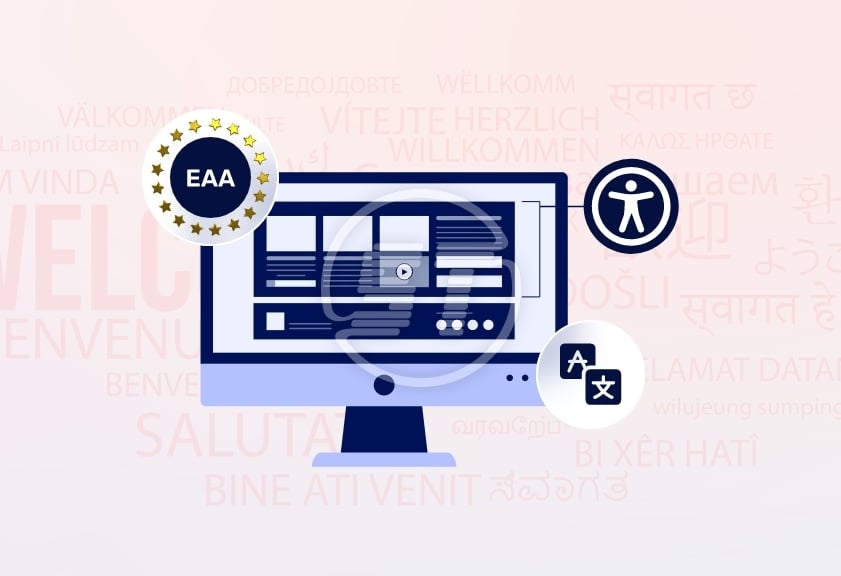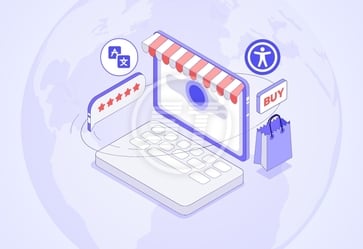Multilingual accessibility = original content served with similar essence to every visitor irrespective of their languages.
Europe is a mosaic of cultures, languages, and digital expectations. With 24 official languages and hundreds of regional dialects, the European market presents both opportunities and challenges for digital businesses. Since accessibility laws have become strict over time and user diversity expands, multilingual accessibility - the practice of ensuring content is both linguistically and digitally inclusive - has become a key differentiator for brands operating in Europe.
This article explores various aspects of multilingual accessibility in Europe.
The European digital landscape: Diversity at scale
Europe’s digital population exceeds 500 million and this audience has different communication languages. Even within multilingual nations like Belgium or Switzerland, people prefer interacting with content in their native language.
- Language diversity: 24 official EU languages, plus recognized regional and minority tongues like Basque, Catalan, and Welsh.
- Regulatory diversity: Each country interprets accessibility guidelines differently, adding another layer of complexity to the issue.
- Cultural diversity: Language shapes trust, emotion, and engagement - critical factors for conversions and brand loyalty.
In such a landscape, an English-only website or app risks alienating a significant portion of users struggling with comprehension or navigation.
Accessibility laws and compliance drivers
The European Accessibility Act (EAA), effective from June 2025, mandates that products and services - both online and offline - be accessible to`` people with disabilities. However, linguistic accessibility indirectly supports these mandates.
- WCAG & EN 301 549 compliance: These frameworks emphasize perceivable and understandable content – both of which rely on clear, localized communication.
- Public sector requirements: Under the EU Web Accessibility Directive, public websites must ensure content is available in all national languages.
- Private sector influence: Companies expanding across borders must localize accessibility statements, forms, and help content to comply with regional laws.
In essence, multilingual accessibility strengthens compliance readiness while ensuring a consistent, user-friendly experience across linguistic boundaries.
Multilingual accessibility as a user-centric imperative
Accessibility isn’t only about screen readers or color contrast - it’s about content understanding in every aspect. A fully accessible design loses impact if the user cannot comprehend its language or contextual meaning.
- Cognitive accessibility: Simplified, plain-language versions help users with learning disabilities or non-native speakers.
- Assistive technology compatibility: Translated alt text, ARIA labels, and captions ensure screen readers and voice assistants work seamlessly across languages.
- Inclusive user experiences: Offering accessible multilingual options build trust, reduce frustration, and improve engagement metrics.
When users can both access and understand content, digital property becomes meaningful and inclusive.
Business value: From compliance to competitive advantage
For businesses operating in the EU, multilingual accessibility offers tangible commercial benefits:
- Expanded market reach: Accessible, localized content attracts users across multiple countries and demographics.
- Improved SEO and discoverability: Search engines favor multilingual, accessible websites that serve diverse audiences.
- Enhanced brand reputation: Demonstrating cultural and linguistic respect fosters brand loyalty and public trust.
- Reduced legal and compliance risks: Meeting EAA and WCAG obligations lowers the risk of penalties or damage to reputation.
In competitive sectors like ecommerce, healthcare, or finance, this combination of inclusivity and reach can drive measurable ROI.
Implementing multilingual accessibility: best practices
Achieving multilingual accessibility requires a combination of linguistic accuracy, technical optimization, and awareness of accessibility.
Some of the important steps include:
- Localize, don’t just translate
- Use accessible multilingual website structures
- Translate all accessibility elements
- Maintain consistency across languages
- Apply plain language principles
- Test with native speakers and assistive tools
- Ensure multilingual compatibility in PDFs and media
- Comply with regional accessibility laws
Go beyond literal translations. Adapt tone, phrasing, examples, and visuals to align with local cultural norms and user expectations. For example, a phrase that resonates with users in France may not have the same emotional impact in Poland or Spain.
Ensure each language version of the website has a clear structure and navigation. Use proper hreflang tags to help search engines deliver the right content to the right users. Language switching options should be accessible via keyboard navigation and screen readers.
Don’t overlook accessibility metadata. Translate alt text, ARIA accessibility, captions, form instructions, error messages, and PDF documents into each supported language. This ensures that users relying on assistive technologies receive equivalent information.
Keep layouts, menus, and functionality uniform across all language versions. Consistency helps users with cognitive disabilities or low digital literacy navigate the site easily, even when they switch languages.
Write in simple, concise language to enhance readability for users with cognitive disabilities and non-native speakers. Avoid jargon, idioms, or culturally loaded expressions that may not translate effectively.
Conduct accessibility testing testing for each language version using native speakers, screen readers, and voice navigation tools. This helps uncover linguistic or structural issues that automated translators might miss.
For organizations sharing downloadable documents or videos, ensure that PDFs are tagged correctly in each language and that captions or transcripts are available in localized formats.
Stay informed about both EU-wide regulations (like the European Accessibility Act) and country-specific accessibility requirements. This ensures that the organization’s multilingual accessibility strategy aligns with local compliance expectations.
The future of multilingual accessibility in Europe
With AI-driven translation and localization tools becoming more sophisticated, the future of multilingual accessibility looks promising. Technologies such as real-time caption translation, AI voice assistants, and accessible multilingual chatbots are reshaping how brands communicate inclusively.
Moreover, as the EAA enforcement date (June 2025) approached, accessibility and localization are increasingly overlapping in digital transformation strategies. Businesses that integrate both now will lead in customer satisfaction, compliance, and innovation.
Read more: WCAG 2.2 & EAA readiness for Seasonal Campaign Accessibility
In a nutshell,
Multilingual accessibility is more than a regulatory requirement – it’s a moral, cultural, and economic imperative in the European market. It ensures that every user – regardless of language, ability, or background – can engage meaningfully with digital content.
By embracing this inclusive approach, organizations not only meet compliance goals but also strengthen brand equity, trust, and long-term growth across Europe’s diverse landscape.
Empower your digital presence for Europe’s diverse audience. Start by assessing the website’s multilingual accessibility readiness - ensure that the content speaks to every language of inclusion.
Looking to make digital experiences more inclusive for Europe’s diverse audience? We offer multilingual accessibility remediation solutions that streamline compliance, elevate usability, and support broader market reach. Connect with us
hello@skynettechnologies.com to explore tailored audits, remediation, and automation options designed to strengthen accessibility across all language customers rely on.


